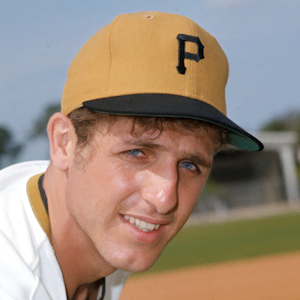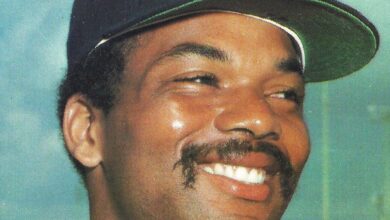
Not many Pirates fans would number him among their favorite players — or even remember him. He was a Pirate for less than a season and a half. To my knowledge, he’s never come back to Pittsburgh to make personal appearances on behalf of his former team. His Wikipedia page is shorter than this paragraph. Regardless, I’ve always had an affinity for former Pirates pitcher John Morlan.
I was there when he made his major league debut, starting the first game of a doubleheader against the San Diego Padres, at Three Rivers Stadium on July 20, 1973. I was 15 years old. My friends and I weren’t necessarily there to see Morlan’s debut. We simply could never pass up an opportunity to see two games from the one-dollar general admission seats. In any case, it was the first time I was ever present for a Pirates starting pitcher’s debut in the majors. Somehow, being there at the beginning made me feel invested in Morlan’s career.
The debut
On that night, the 25-year-old Morlan got off to a rocky start, surrendering two singles in the first inning but limiting the Padres to one run. Willie Stargell belted a two-run homer off Padres starter Randy Jones in the bottom of the first. With a 2-1 lead, Morlan, looking poised, held the Padres scoreless over the next three innings, facing just 10 batters.
In the bottom of the third, Morlan strode to the batter’s box for his first plate appearance of the season anywhere. (The designated hitter was being employed in the International League, from where he came.) Morlan shocked the crowd by smoking a double to deep left field. The crack of the bat resonated throughout the half-full concrete stadium as he made his way to second base standing. He would eventually score on a sacrifice fly by Al Oliver.
Alas, in the fifth inning, he gave up two singles, a sacrifice bunt by Jones, and two more singles as the Padres tied the game at 3-3. Although the Padres weren’t exactly tearing the cover off the ball, at that point manager Bill Virdon removed Morlan from the game. Morlan headed to the dugout to enthusiastic applause. Despite beginning his career with an unsightly 6.23 ERA, there was a general feeling in the stands that he had pitched well. (The Pirates eventually won the game on Rennie Stennett‘s 10th-inning homer.)
After the game, Morlan told The Pittsburgh Press he was “pitching dumb” in the fifth inning. “I was so worried about throwing strikes,” he said, “that I wasn’t pitching.” Even so, Virdon saw enough to declare Morlan would get more starts.
John who?
Originally from Columbus, Ohio, Morlan was a first-round draft choice of the Pirates in 1969. He had previously been drafted three other times since 1965 and opted to stay in school each time. Drafted as an outfielder, he combined careers as a professional baseball player and an elementary school teacher, prioritizing the latter. He would join his minor league team in June of each year, after the school year was completed. After two years that yielded dismal batting averages, he wrote to Pirates farm director Harding Peterson, suggesting he was wasting him time in baseball and wanted to quit. Peterson instead convinced him to convert to pitching, which Morlan had done with some success at Ohio University. Morlan gave it a try, retiring from teaching in time to join the Pirates for spring training, albeit late, in 1973.
The mess that was 1973
Morlan was cut in that spring, which was no surprise, as he had yet to pitch above single-A. Meanwhile, the 1973 season was an unmitigated disaster for the Pirates. The team was coming to grips with the untimely death of superstar Roberto Clemente on the previous New Years Eve. Steve Blass, a 19-game winner in 1972, suddenly lost the ability to throw strikes. Stargell and his aching knees were moving to first base, leaving vacancies in both left and right field. The outfield spots could have been capably filled by Gene Clines and Vic Davalillo, who hit .334 and .318, respectively, in 1972. Even Stennett, who hit .286 in 1972, could have been another option. An infielder by trade, he acquitted himself quite well as a left fielder in the 1972 National League Championship Series.
Instead, foolish decisions were made. Perennial All-Star catcher Manny Sanguillen was asked to play right field so Milt May could move in behind the dish. Bob Robertson, a lumbering first baseman who hit .193 in 1972, was groomed as the left fielder in spring training. When he won the job with a good spring, right before Opening Day it was decided he and Stargell would switch back to their normal positions. Eventually the 1973 season would include a verbal confrontation between Virdon and Richie Hebner, followed by a bizarre press conference during which general manager Joe L. Brown would announce he had nothing to announce.
Morlan gets the call
Meanwhile, Morlan simply went about his business with the triple-A Charleston Charlies. Brown had wanted him to get more experience before making the big club. However, Morlan’s performances were becoming harder and harder to ignore. On June 17, he came within two outs of pitching a no-hitter for the Charlies, beating the Peninsula Pilots, 11-2, and improving his record to 8-3. On July 8, he pitched a four-hitter against the Tidewater Tides and won, 8-4. Finally, with a record of 11-5 to go with a minuscule 2.09 ERA and nine complete games, Brown had no choice but to call him up to the reeling Pirates on July 18. Announced as the starter for the first game of the doubleheader against the Padres, Morlan told Jeff Samuels of The Pittsburgh Press, “I just hope I don’t fall on my face. I don’t think I will.”
On August 3, in his third start for the Pirates, Morlan earned his first major league win, 3-1 over the Philadelphia Phillies and future Hall-of-Fame pitcher Steve Carlton at Veterans Stadium. Morlan pitched seven innings of four-hit ball before admitting to Virdon he was tired. Ramon Hernandez took over and earned the save.
Morlan added his first and only major league complete game to the back of his baseball card on August 21, 1973, besting the Astros, 6-3, in the Astrodome. It was a gutsy performance during which he allowed nine hits, two of which were home runs, and two walks. Afterward, he admitted to a pool of reporters he’d been nervous. “Maybe I am the Don Knotts of this game,” he said, referring to the actor who portrayed jittery Barney Fife on The Andy Griffith Show. “I don’t know. All I know [is] I was nervous.”
A disappointing end
Morlan’s final start of 1973, at home against the St. Louis Cardinals on September 5, didn’t go so well. He was removed after just one third of an inning, giving up three runs in a 5-3 loss. It was also Virdon’s final game as Pirates manager. Former Pirates manager Danny Murtaugh took over and removed Morlan from the rotation in favor of the struggling Blass, telling Charley Feeney of the Pittsburgh Post-Gazette, “I would rather try Blass than go with a rookie.” Morlan was used twice more in 1973, relieving in lost causes.
The Pirates lost all three of Blass’s September starts. They finished two and one-half games behind the first place New York Mets. It just wasn’t meant to be for the Pirates in 1973. It was the only year from 1970-75 they didn’t win the National League East Division. The Mets were the team of destiny in 1973. They had brought Willie Mays back to New York in 1972. Sentiment weighed heavily in favor of “The Say-Hey Kid” getting one more shot at a World Series.
The aftermath
Morlan remained with the Pirates for all of 1974 but never got to start another game. The team had beefed up its starting pitching with offseason trades for Jerry Reuss and Ken Brett. Even so, Murtaugh, despite paying lip service to the contrary, never seemed to have the same confidence in Morlan as had Virdon. Morlan pitched in 39 games in 1974, all in long relief or mop-up roles. That was the end of his major league career, which he finished with a record of 2-5, a 4.16 ERA and, for all you analytics geeks out there, a WHIP of 1.575, a FIP of 4.25 and an “OPS-Against” of .716 over 49 games.
Morlan hung around triple-A in the Pirates’ system until a few games into the 1977 season, when he called it quits. Thereafter, it seemed he dropped right off the face of the earth. I was able to find out, as of 2003, he was on the board of directors of the Batter’s Box Academy in Columbus, where he was also a high school baseball coach. I also found a 2012 baseball blog where he agreed to answer a few innocuous questions. Unfortunately, it had no information on what he happened to be doing at the time. Regardless, for one 15-year-old, he made the tumultuous 1973 Pirates season fun for some seven weeks.





